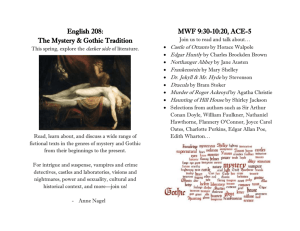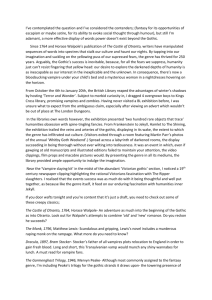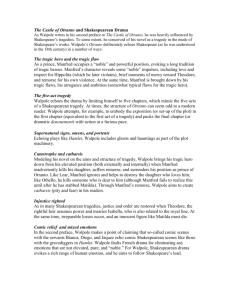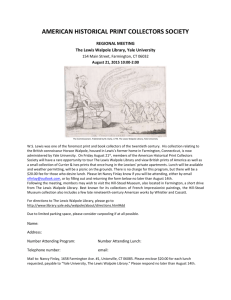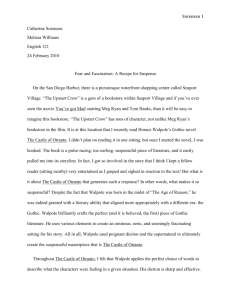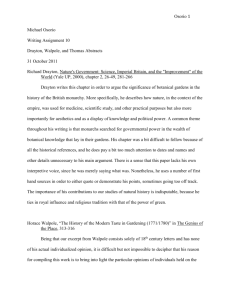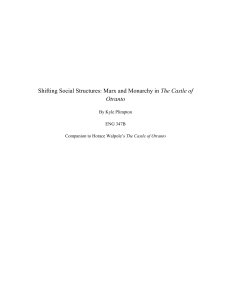Character Archetypes in Otranto
advertisement
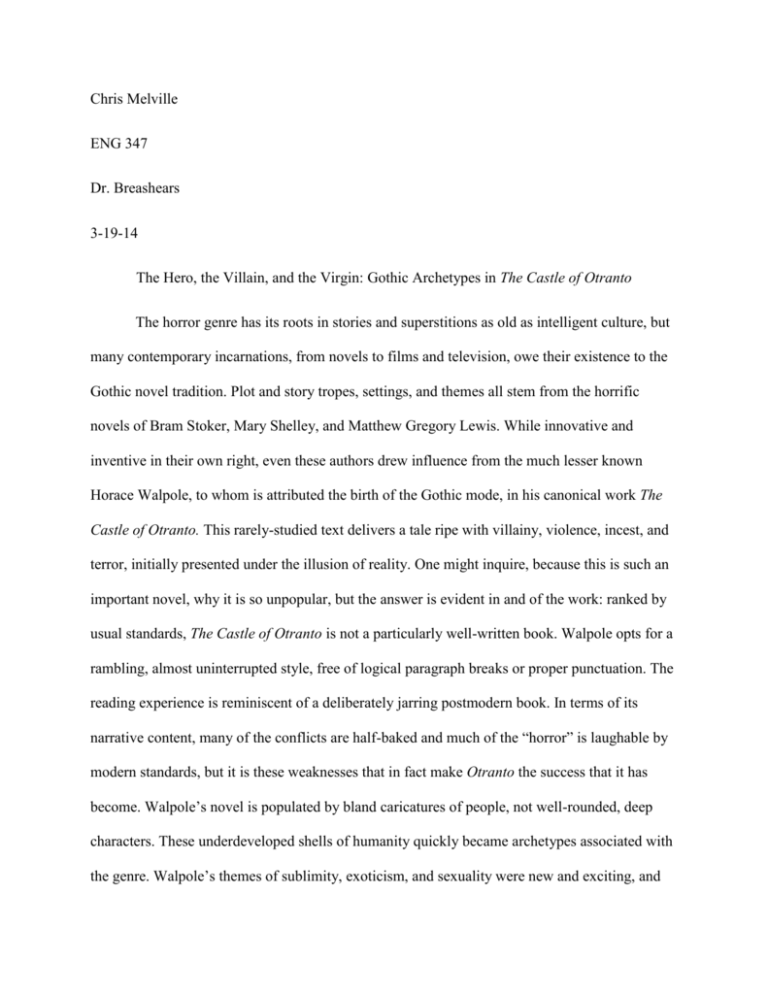
Chris Melville ENG 347 Dr. Breashears 3-19-14 The Hero, the Villain, and the Virgin: Gothic Archetypes in The Castle of Otranto The horror genre has its roots in stories and superstitions as old as intelligent culture, but many contemporary incarnations, from novels to films and television, owe their existence to the Gothic novel tradition. Plot and story tropes, settings, and themes all stem from the horrific novels of Bram Stoker, Mary Shelley, and Matthew Gregory Lewis. While innovative and inventive in their own right, even these authors drew influence from the much lesser known Horace Walpole, to whom is attributed the birth of the Gothic mode, in his canonical work The Castle of Otranto. This rarely-studied text delivers a tale ripe with villainy, violence, incest, and terror, initially presented under the illusion of reality. One might inquire, because this is such an important novel, why it is so unpopular, but the answer is evident in and of the work: ranked by usual standards, The Castle of Otranto is not a particularly well-written book. Walpole opts for a rambling, almost uninterrupted style, free of logical paragraph breaks or proper punctuation. The reading experience is reminiscent of a deliberately jarring postmodern book. In terms of its narrative content, many of the conflicts are half-baked and much of the “horror” is laughable by modern standards, but it is these weaknesses that in fact make Otranto the success that it has become. Walpole’s novel is populated by bland caricatures of people, not well-rounded, deep characters. These underdeveloped shells of humanity quickly became archetypes associated with the genre. Walpole’s themes of sublimity, exoticism, and sexuality were new and exciting, and appealed to authors like Lewis, Shelley, Stoker, Byron, and others, all of whom adapted these ideas into their own more successful and respected works. Since the characters of Otranto were intrinsically attached to the themes, they, too, were adapted. Walpole’s visions of Heroes, Villains, and Virgins quickly became definitive of the genre, still recognizable into today’s horror movies. Perhaps the most intriguing of Walpole’s archetypes is the prototypical Gothic villain. Again, his is merely a mannequin, a poorly drawn amalgamation of vague concepts without any real substance, but upon which better authors can easily create something clever and fascinating. The primary antagonist of The Castle of Otranto is Manfred, a crazed patriarch determined to extend his family line, willing even to rape his would-be daughter-in-law. The key thing Walpole does here, though, is build a villain based on abhorrent primal desires, and designed in stark contrast to the virtuous protagonists. His introduction into the novel is as sparse and unceremonious as any other, but Walpole wastes no time in misdirection, immediately characterizing him with only one descriptor: impatient (17). He stresses this impatience heavily throughout the novel: Manfred is, “Impatient of the least delay,” and, “less apprehensive than enraged at the procrastination of the nuptials” (18). This eagerness to see Conrad wed is only more exaggerated in his desire to take Isabella as his own following Conrad’s death. Above all else, Manfred is obsessed with the perpetuation of his genealogy, a goal he pursues with almost supernatural fervency. This tenacity is one of the key components of the Gothic villain. For example, in Matthew Gregory Lewis’ The Monk, the corrupted Ambrosio possesses an unwavering lust for Antonia, who turns out to be his sister. In pursuit of Antonia, Ambrosio lies, cheats, drugs Antonia, murders his own mother, rapes Antonia in crypt, and even sells his own soul to the devil. Ambrosio’s insatiable sexual atrocities are merely a realization of Manfred’s unfulfilled desires, which are in themselves implicative of deeper psychological residents. Jill Campbell, in her paper “I Am No Giant,” explores this psychology with reference to a homoerotic overcompensation, and while her theorization of the characters’ sexuality can be debated, her insightful look at the profundity of motive implies a vital aspect to Walpole’s archetype: mystery (238). He of course dispels any ambiguity from his novel with a convenient explanation for Manfred’s actions, but the reader’s frantic assumption that there must be something more to the villain becomes paramount to the developing Gothic tradition. Manfred alone does not formulate the quintessential villain, though. Being human, despite his preternatural determination, Manfred lacks another definitive quality of the Gothic villain: sublimity, which David Morris identifies as one of the most important facets of the genre. As Morris points out in his paper “Gothic Sublimity,” Walpole identifies terror, a key component of sublimity, as his “principle engine” in his preface to Otranto. In the Gothic novel, then, terror and sublimity are intrinsically linked as mutually beneficial properties for development. A Gothic novel cannot be one without being the other (300). The same concept can be applied to the generic villain. Fortunately, Walpole provides that substance in another character, Alfonso, characterized as a giant, ghostly, armored, vengeful spirit. His enormity, grandeur, and supernaturalism automatically establish him as a sublime figure, overpowering the hapless human characters. The incorporation of villainous, but human motivation with an unnatural sublimity evolved into the archetypal horror villain. The division between the two, present in Otranto, remains in The Monk: humanity embodied in Ambrosio and sublimity in Lucifer, but later authors combine the two. Though one could argue that the true villain of Mary Shelley’s Frankenstein is the titular scientist, the antagonist to the narrating characters is clearly the monster: hideous to behold, stunning in its simple existence, but driven by personable desires and frailties. Combining them perhaps more seamlessly, Bram Stoker’s Count Dracula represents the final evolution of the Gothic antagonist. In her paper “The Faces of Evil,” Bridget Marshall discusses the physical attributes of villainy, asserting that the Gothic monster may be sublime in its nature, but it is always ugly in appearance. Given Walpole’s predilection of Shakespeare (Walpole 11), it is a wonder that he neglected to model Manfred more after Richard III or Caliban, but the archetypal base exists for future writers nonetheless, and as Marshall notes, both Frankenstein’s Monster and Dracula are primarily identified by their repulsive faces (162). Lewis perhaps begins this with his demonic description of the devil, a note that Walpole somehow managed to miss, opting instead for a “clap of thunder” and “blaze of glory” (113). Indeed, Lewis’ first describes Lucifer with a similar diction, “His form shone with a dazzling glory” (244), but later inverts that atmosphere for one more sinister. To contrast the otherworldly evil of the villains, Walpole opts for simplistic heroic protagonists, both male and female. The men serve as the obvious antitheses to the male villains. Most importantly in Otranto, Theodore offers a contrast to Manfred. Defined by characteristics of bravery and morality, Theodore is reminiscent of older stock heroes from folklore and mythology. Published in 1764, The Castle of Otranto is in many ways more rooted in the Neoclassical tradition than the Romantic, unlike many Gothic successors. As a result, Walpole may likely have been influenced by the heroes of classical antiquity, many of whom, while flawed, embody a noble spirit and purity of motive. He adapts these qualities into Theodore, the gallant knight who rescues multiple damsels over the course of the narrative, but Walpole further develops the archetype by imbuing it with some mystery. Theodore initially appears as an unnamed peasant who secretly harbors a noble genealogy. The concept of the intriguing, suave, mysterious, handsome, secretly noble, bold youth becomes the favored hero in the Gothic, and perhaps eventually evolves into the Byronic hero, but future authors dramatically complicate the type, starting with Lewis. In The Monk, the heroes are Lorenzo and, perhaps to a lesser extent, Don Raymond. Lorenzo is even more one-dimensional than Theodore, never actually preserving his true identity from his desired Antonia, but Raymond offers an unexpected progression. Like almost all the characters in The Monk, Raymond is a more corrupted version of his Otranto archetype, disguising himself on many occasions and even engaging in premarital sex, generally frownedupon for an admirable character. The greatest complication of the Gothic hero, however, comes with Frankenstein. Shelley’s mad scientist possesses many of the important characteristics of the type, but fails in almost every heroic pursuit, in fact propelling the main conflict and inadvertently causing the deaths of several innocents, including members of his own family. With reference to The Monk, Francis Hart suggests in “The Experience of Character in the English Gothic Novel,” that all men in the genre are, to some degree, wicked at heart, or, as Hart puts it, “Diabolism is in every man” (102). This grim observation builds one of the fundamentals of the Gothic: that evil, whether dormant or active, is everywhere. No man is pure enough to fully resist or avoid its beckon. That is the basic plot of The Monk, but also continues to exist in contemporary horror fiction. The 1941 film The Wolf Man places the theme in eloquent terms, “Even a man who is pure of heart and says his prayers by night, may become a wolf when the wolfbane blooms and the autumn moon is bright.” Complementing the hero, and usually serving as a romantic interest, the Gothic female protagonist is almost always an innocent young virgin, sheltered from sin and idealized beyond reason. This is the one unchanging archetype. In The Castle of Otranto, Walpole has two virgins, Isabella and Matilda; in The Monk, Lewis has Antonia; Shelley writes Elizabeth in a similar way in Frankenstein; Polidori’s Miss Aubrey embodies an almost ethereal purity in The Vampyre: “There was a melancholy charm about it which did not seem to arise from misfortune, but from some feeling within, that appeared to indicate a soul conscious of a brighter realm” (306). In all works, the virgin operates as the object of sexual desire both for the hero and the villain, and surprisingly, it is usually the villain who prevails. Ambrosio successfully rapes Antonia, condemning her from Lorenzo; the monster murders Elizabeth on Frankenstein’s wedding night; Lord Strongmore consumes Miss Aubrey’s blood, killing her. This triumph of monstrosity over purity begins with The Castle of Otranto, when Manfred murders Matilda—his own daughter— whom Theodore loves over Isabella. For both Otranto and The Monk, though, the solution provides the virtuous hero with an alternate lover: Isabella for Theodore and Virginia for Lorenzo, basically rewarding male purity and punishing or at least disregarding female. While Antonia and Virginia almost perfectly fill the roles of Matilda and Isabella, Lewis does convolute the archetype a fair amount. Considerably more than most Gothic novels, The Monk boasts a surprisingly extensive female cast. Beyond the two virgins are two corrupted women: Agnes and Matilda. The former is lover and intended to Don Raymond, who is excessively punished for her sexual transgressions, suffering more than her due for both members of the couple. The more fascinating character for the conversation about archetypes is inarguably Matilda. Lewis selected the name as an obvious reference to Walpole, but his Matilda is almost a part-by-part inversion. At the start of the novel, Lewis’ Matilda is enough alike to Walpole’s to satisfy comparison, presented as a beautiful virgin at first, even posing as the model for a portrait of the Virgin Mary, but Lewis is quick to reverse expectations, and Matilda soon assumes the role of antagonist, corrupting Ambrosio and, in a dramatic climax, Lucifer reveals that she is not even human, but a demon under his command. Peter Grudin’s character study into Lewis’ Matilda offers a great deal of insight into her burgeoning treachery in his paper on “The Rhetoric of Deceit,” considering her as an oxymoronic human demon. In making her so evil, Lewis actually managed to create a layered, complex, more realistic and believable character than the typical virgin that Walpole provides in his Matilda (137). Though Lewis may have intended his Matilda as a critical jab at Horace Walpole, his innovation is a perfect example of how future authors adapted and played with the archetypes created in The Castle of Otranto. Despite tropes and standards, this further asserts that the horror genre is not static. In his paper “Framing the Gothic,” Mark Hennelly discusses the versatility of horror. Like any genre, horror is not wholly constricted by its clichés. It can be, but those are usually considered weak pieces that cannot progress beyond the basic infrastructure. The archetypes that Walpole created in The Castle of Otranto are still widely used today. One of the best examples of this is the recent film The Cabin in the Woods, directed Drew Goddard and co-written with Joss Whedon. The film purposely and self-reflexively identifies its characters as archetypes and defines them in archetypal terms, including the “virgin” and the “whore.” Somehow despite the numerous stylistic shortcomings of narrative blandness of The Castle of Otranto, its legacy survives; in fact it survives because of its faults. Instead of creating a fully developed story with interesting people, Walpole wrote an otherwise forgettable tale that possessed just enough spark to inspire future writers of horror. Works Cited The Cabin in the Woods. Dir. Drew Goddard. Perf. Kristen Connelly, Chris Hemsworth. Lionsgate, 2012. Film. Campbell, Jill. “’I Am No Giant’: Horace Walpole, Heterosexual Incest, and Love Among Men.” The Eighteenth Century 39.3 (1998): 238-260. JSTOR. Web. 1/29/14. Grudin, Peter. “The Monk: Matilda and the Rhetoric of Deceit.” The Journal of Narrative Technique 5.2 (1975): 136-146. JSTOR. Web. 1/31/14. Hart, Francis Russell. “The Experience of Character in the English Gothic Novel.” Experience in the Novel. Ed. Roy Harvey Pearce. New York: Columbia UP, 1968. 83-105. Print. Hennelly, Mark. “Framing the Gothic: From Pillar to Post-Structuralism.” College Literature 28.3 (2001) 68-87. JSTOR. Web. 2/2/14. Lewis, Matthew Gregory. The Monk. New York: Broadview, 2004. Print. Marshall, Bridget M. “The Face of Evil: Phrenology, Physiognomy, and the Gothic Villain.” Hungarian Journal of English and American Studies 6.2 (2000) 161-172. JSTOR. Web. 2/19/14. Polidori, John. “The Vampyre.” Frankenstein. Ed. D.L. Macdonald and Kathleen Scherf. Buffalo, NY: Broadview, 2012. 293-312. Print. Shelley, Mary. Frankenstein. Buffalo, NY: Broadview, 2012. Print. Walpole, Horace. The Castle of Otranto. New York: Oxford UP, 2008. Print. The Wolf Man. Dir. George Waggner. Perf. Claude Rains, Lon Chaney Jr. Universal Studios 1941. Film.

